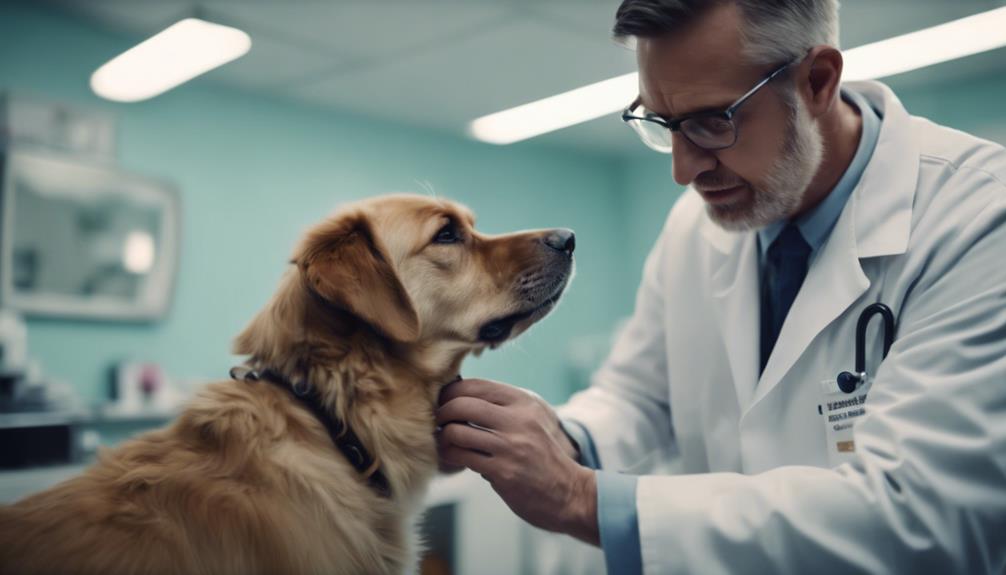Anemia in dogs poses a significant health concern that demands a nuanced understanding to address effectively. With various causes and types, recognizing the symptoms and establishing a tailored treatment plan is paramount.
From regenerative to non-regenerative forms, each case requires careful evaluation to determine the appropriate course of action. By exploring the diverse treatment options available, including blood transfusions and medications, veterinarians work to restore balance and vitality to affected animals.
Stay tuned to uncover the preventive strategies crucial in managing and potentially averting this condition in our beloved canine companions.
Key Takeaways
- Anemia in dogs has various causes, including blood loss and bone marrow dysfunction.
- Treatment options range from blood transfusions to long-term care based on the underlying cause.
- Regular veterinary check-ups and preventive measures can help manage and reduce the risk of anemia.
- Diagnostic testing, including blood work and X-rays, is crucial for accurate diagnosis and appropriate treatment.
Understanding Anemia in Dogs
Understanding the intricacies of anemia in dogs necessitates a grasp of the loss, destruction, or decreased production of red blood cells (RBCs) that characterize this condition. Anemia can be regenerative, where the bone marrow can compensate by producing more RBCs, or non-regenerative, where the bone marrow is unable to increase RBC production.
Regenerative anemia often occurs due to blood loss, while non-regenerative anemia may result from conditions affecting bone marrow function or causing the destruction of RBCs. Recognizing the type of anemia is crucial for determining appropriate treatment strategies and understanding the prognosis for affected dogs.
Causes and Types of Anemia
Anemia in dogs can arise from various causes and manifest in different types, each presenting unique challenges for diagnosis and treatment. The main types of anemia in dogs include blood loss, aplastic anemia, methemoglobinemia, and hemolytic anemia.
Blood loss anemia can result from trauma, parasites, or underlying diseases like ulcers. Aplastic anemia occurs when the bone marrow fails to produce enough red blood cells. Methemoglobinemia is characterized by an abnormal form of hemoglobin in the blood, often caused by toxins. Hemolytic anemia is triggered by the destruction of red blood cells, which can be immune-mediated or due to inherited conditions.
Understanding the specific type of anemia is crucial for implementing the appropriate treatment plan.
Signs and Diagnosis of Anemia

Symptoms indicative of anemia in dogs encompass a range of clinical manifestations that prompt thorough investigation and diagnostic assessment. These may include pale gums, lethargy, weight loss, dark stools, visible blood loss, reduced appetite, bruises, rapid breathing, and jaundice.
Diagnosis involves a detailed history, physical examination, and diagnostic testing like blood work, urinalysis, X-rays, and bone marrow analysis. Blood smear analysis is utilized to examine RBC characteristics such as size, shape, and color.
Identifying the underlying cause of anemia is crucial for determining the most effective treatment approach. Prompt recognition and accurate diagnosis of anemia in dogs are essential in ensuring appropriate management and improving the overall prognosis for affected animals.
Treatment of Anemia in Dogs
When addressing anemia in dogs, the treatment approach varies depending on the specific underlying cause identified through diagnostic assessments. Treatment of anemia in dogs may involve addressing the root cause of the condition to effectively manage it.
Here are some common treatment options:
- Blood Transfusions: In emergencies, transfusions may be necessary to restore blood volume.
- Parasite-Killing Medication: Treating parasites can help resolve anemia caused by parasitic infestations.
- Cancer Treatment: Addressing cancer can improve anemia associated with malignancies.
- Intravenous Fluids and Supportive Care: Providing fluids and supportive care can help manage anemia and improve the dog's overall condition.
Blood Transfusions and Other Treatments

Addressing anemia in dogs often involves implementing critical treatments such as blood transfusions and other targeted interventions based on the specific underlying causes identified through diagnostic evaluations. Blood transfusions are crucial in emergencies to restore blood volume. Other treatment options may include parasite-killing medication, cancer treatment, intravenous fluids, and long-term care for chronic diseases causing anemia. Supportive care is provided in severe cases where anemia may be untreatable.
| Treatment Type | Description |
|---|---|
| Blood Transfusions | Emergency measure to restore blood volume quickly. |
| Parasite-Killing Medication | Used when parasites are the cause of anemia. |
| Cancer Treatment | Necessary if cancer is causing the decrease in red blood cells. |
| Intravenous Fluids | Helps maintain hydration and support the circulatory system during treatment. |
Prevention and Care Strategies
To enhance the overall well-being of dogs and mitigate the risk of anemia, proactive measures through vigilant veterinary monitoring and comprehensive care protocols are imperative. Implementing preventive strategies can significantly reduce the likelihood of anemia development in dogs.
Prevention and Care Strategies:
- Regular Veterinary Check-ups: Schedule routine visits to detect any early signs of anemia or underlying health issues.
- Proper Nutrition: Ensure a balanced diet rich in essential nutrients to support overall health and prevent nutritional deficiencies.
- Parasite Control: Regularly administer parasite prevention medications as parasites can contribute to anemia.
- Management of Underlying Health Issues: Treat and manage pre-existing conditions promptly to reduce the risk of anemia.
Importance of Regular Veterinary Check-ups

Regular veterinary check-ups are essential for maintaining the health and well-being of dogs by allowing early detection of potential health issues, including anemia. These routine visits help veterinarians monitor your dog's overall health, conduct necessary screenings, and provide preventive care to keep your furry friend healthy. Below is a table illustrating the importance of regular veterinary check-ups in preventing and managing anemia in dogs:
| Benefits of Regular Veterinary Check-ups | How It Helps Prevent Anemia | Frequency |
|---|---|---|
| Early detection of health issues | Allows prompt treatment of underlying causes of anemia | Yearly |
| Monitoring of blood parameters | Helps identify changes in red blood cell counts | Bi-annually |
| Parasite prevention and control | Reduces the risk of blood loss anemia due to parasites | Every 3-6 months |
Conclusion
In conclusion, anemia in dogs is a complex medical condition that can have serious implications on their health and well-being. Understanding the causes, types, treatment options, and prevention strategies is crucial for pet owners and veterinary professionals.
By prioritizing regular veterinary check-ups, proper nutrition, and disease management, pet owners can play a proactive role in safeguarding their canine companions against the debilitating effects of anemia.




